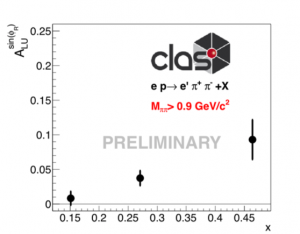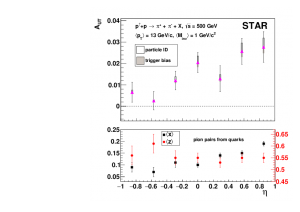First data on beam-spin asymmetries of di-hadron pairs at CLAS12 shown at DNP
I just came back from the Division of Nuclear Physics meeting of the APS where I could show our first data on beam spin asymmetries from hadron pairs:
This plot shows the asymmetry vs. x Bjorken (roughly the momentum that the struck quark carries of the parent nucleon). There is a very suggestive rise of the measurement that can be interpreted as the force that the gluons exert on a transversely polarized quark as it moves through the proton after being struck.
This is quite interesting since it open up a window to quark-gluon interactions inside the proton and because our understanding is that quarks can only have transverse polarization in an unpolarized nucleon if they also carry transverse momentum (Boer-Mulders effect).
More background can be found in my recent write-up here:
https://arxiv.org/pdf/1810.02435.pdf

Belle II might revamp the standard model
…well we already knew that, but it made the list of the three experiments which might revamp the standard model in this article here:
https://www.sciencenews.org/article/new-particle-physics-experiments-revamp-standard-model
Paper on the first observation of transverse Lambda polarization submitted to PRL
Finally, we submitted the paper about our result:
http://inspirehep.net/record/1687566
Anselm Vossen awarded DOE Early Career Award
Anselm Vossen was awarded the DOE Early Career Award. See press release here.
Our paper on the “Measurement of the branching fraction of B→D(∗)πℓν at Belle using hadronic tagging in fully reconstructed event” is on the arxiv and submitted to PRD
The paper can be found here:
Our paper “Transverse spin-dependent azimuthal correlations of charged pion pairs measured in p↑+p collisions at √s = 500 GeV” was accepted by PLB
Our paper presents the most precise measurements sensitive to the transversity distribution in p+p yet. This plot shows the results vs Eta which corresponds to the momentum the quark we are probing is carrying. As expected from previous measurements. Quarks carrying a higher momentum fraction of the proton tend to also exhibit a higher polarization.

As shown in here, the average Q2 of this measurement (STAR 500 GeV) is substantially larger than previous measurements, corresponding to a deeper look inside the proton.

First global extraction of transversity using our data from e+e- and pp
Our knowledge of the proton-wave function is gained mainly from scattering point like probes off the proton at energies high enough that individual quarks and gluons are resolved. In these high energy scattering events we access the proton wave-function in a frame where the proton moves at the speed of light. All components which are not ‘light like’ are suppressed. If one disregards transverse momentum of quarks and gluons, the remaining leading components of the wave-function can be described by three coefficients which correspond to different polarization projections of the wave function and can be accessed by experiments where the polarization of quarks and protons is varied. The least well known coefficient, the so-called transversity, can be identified with the distribution of the transverse polarization of quarks in a transversely polarized proton. Our group has been leading an experimental program in e+e- and pp collisions to extract transversity from di-hadron correlations. This data has now been used for a first extraction of transversity from di-hadron correlations:
Nature Article about Belle II – We expect first collisions this month!
https://www.nature.com/articles/d41586-018-00162-x
Here is a picture of the detector from last year with open endcap doors:

Welcome to the Vossen Group
Please see the menu above for a description of our research and potential thesis topics
Recent Comments